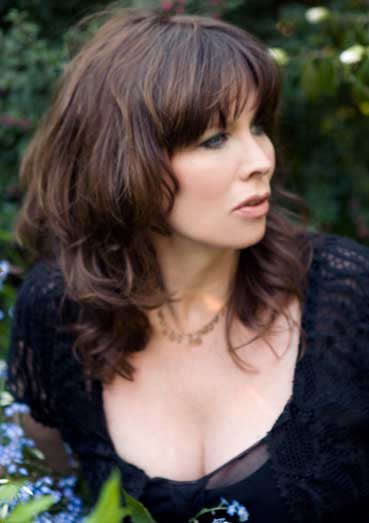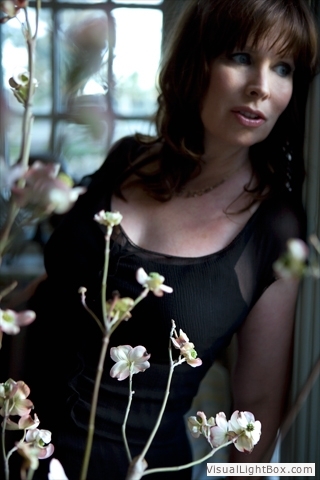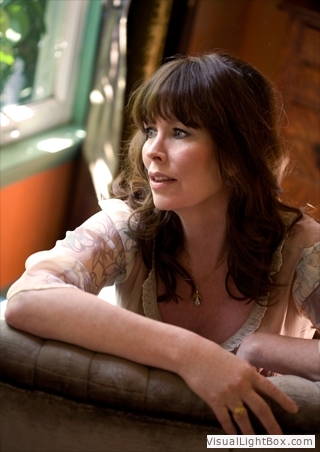Lissy Walker: ‘I wanted to bring together all the things I like about American music.’How Sweet It Is
Bay Area folk-jazz singer Lissy Walker serves up a quiet classic on her debut album, Life Is SweetLissy Walker is a jazz singer, but her wide-ranging musical interests set her apart from your average chanteuse. An actress and singer for most of her life, Walker brings the tools of those trades to bear on her impressive debut album, Life Is Sweet, on which the dramatic sensibility of her jazz vocals is informed by nuances of folk, pop, and country.
"When I started working on the arrangements for Life Is Sweet, I wanted to bring together all the things I like about American music," Walker explains. "Guitarists like Freddie Green [Count Basie] have this folky sense of rhythm in their playing, and country singers like Patsy Cline have a jazz-like phrasing, so bringing those elements together seemed natural. I asked Scott Nygaard to play guitar because his style connects folk, jazz, and bluegrass in a way that complements my thinking about the music. John R. Burr combines jazz piano technique with ragtime, Americana, and a genuine love for folk music, so he was the perfect pianist to work with. I chose songs by writers like Harry Nilsson and Randy Newman because they're the songwriters I love, along with writers we readily associate with the Great American Songbook, as well as a few from across the pond, like Ray Davies and Nick Drake."
Walker selected music that resonated with her, along with one, Irving Berlin's "Isn't This a Lovely Day," that was a new revelation. "I found 'Lovely Day' in an Irving Berlin songbook," she says. "I'd never heard it before, but as I played it out on the piano, I knew it would be a good fit. I tend toward happy melodies with sad lyrics or vice versa, tunes that look at both sides of the coin. Several songs deal with mortality, or the ache of a broken heart, but the underlying theme of the album is redemption-how love affects our ability to embrace life and acknowledge the limitations of existence, and that beauty can be found in melancholy-the idea that a broken heart is better than no heart at all."
‘The underlying theme of the album is redemption—how love affects our ability to embrace life and acknowledge the limitations of existence, and that beauty can be found in melancholy-the idea that a broken heart is better than no heart at all.’Walker produced Life Is Sweet with bassist Jon Evans (Tori Amos, Spencer Day). The arrangements are by Walker and pianist John R. Burr. Drummer Scott Amendola (Madeleine Peyroux, Nels Cline) and Grammy-nominated guitarist Scott Nygaard complete the basic quartet. Cellist Philip Worman, organ player Julie Wolf (Ani Di Franco), trumpeter Steven Bernstein (Rufus Wainwright), and Dave Ellis on sax added discreet overdubs. "We left room in the arrangements for improvisation," Walker says. "We worked out the feel of the songs, coming up with specific interpretations, the intros and endings, and then let the ideas flow."
Walker's burnished vocals have a hint of restrained passion that suggests country music, but her phrasing, which dances around before and after the beat, is pure jazz. Her low-key approach is folky at times, but raw emotion lurks just beneath the surface, adding an alluring tension to her performances.
The album opens with "I Remember You." The band takes the tune at a sprightly tempo but Walker's expressive, ethereal singing is slightly behind the beat creating the intense, heady energy of a new love affair. "When he wrote this song, Johnny Mercer had an intense crush on Judy Garland," Walker says. "The lyric is in the present moment, sung as a flirtation, and then soars up into the heavens to give the song a giddy, breathless sense, like you've died and gone to heaven."
Lissy Walker - Life is Sweet from Lissy Walker on Vimeo.
Burr's piano on Irving Berlin's "How Deep Is the Ocean?" lays down a laid-back, sultry, jazz groove, with just a hint of vintage '60s country music. Walker's smoky vocal implies the excitement and hesitance of an anxious lover. Burr's piano and Worman's cello bring some warmth to the almost fatalistic lyric. Walker's playful vocal and swooning harmonies add an extra rhythmic element to Jobim's "Waters of March." Evans plays subliminal lap steel to augment the track's dreamy aura.
Walker first heard "What'll I Do?" on the soundtrack of Robert Redford's film The Great Gatsby when she was quite young, and it has stuck with her ever since. Audiences frequently are moved to tears when Walker sings it in clubs. It's played here as a solemn country waltz, with Worman's wistful cello complementing Walker's wrenching vocal. Randy Newman's "Let Me Go" gets a sassy ragtime treatment, as does Irving Berlin's "Isn't This a Lovely Day?," another song with a skewed worldview. Burr's honky-tonk piano and Bernstein's muted trumpet suggest the allure of an after-hours club in the '30s.
The Kinks' "Celluloid Heroes" first appeared on the album Everybody's in Show-Biz. Walker liked the song's melancholy yet hopeful melody. Its noirish humor makes it work perfectly as a torch song, Walker says, while its poignant melody and references to Monroe, Garbo, Valentino, and Bette Davis give it a timeless feel. Few singers cover the late Nick Drake (although his songs have curiously found favor with TV advertisers), a jazz/folk songwriter with a poet's soul and a heart of darkness. Walker closes the album with Drake's "Saturday Sun," her optimistic vocal, the soaring sax of Dave Ellis, and Burr's gospel-tinged piano bringing a hint of salvation to the haunting lyric.
Lissy Walker was born in Los Angeles but the family migrated north in the late 1960s, finally settling in Berkeley. There, she grew up surrounded by artists, architects, and writers, and lovers of art and music. Both parents were classical music buffs, and it was played night and day. As a child Walker studied classical piano. "I loved playing, and the lessons gave me an important base for all the music I've done," Walker recalls. "When I discovered ragtime, I asked if I could take jazz piano. My parents encouraged me to teach myself, so I bought a book of Scott Joplin rags and learned to play ragtime on my own."
‘I tend toward happy melodies with sad lyrics or vice versa, tunes that look at both sides of the coin.’One of the few non-classical records in the Walker home was Ella Fitzgerald’s Ella Sings Rodgers and Hart. "I loved her version of 'Ten Cents a Dance' and used to run home after school to sing along with her," Walker recalls. "When I started buying records, the first album I bought was an Andrews Sisters Greatest Hits compilation. Bette Midler had covered 'Boogie Woogie Bugle Boy,' but the guy at Tower Records gave me the Andrews Sisters' version." Walker soon organized an Andrews Sisters trio with pals from her Girl Scout troop.
"In the seventh grade, I saw A Midsummer Night's Dream and decided I wanted to be an actress," Walker says. "I went to the Young Conservatory at ACT in San Francisco. At Berkeley High School, I studied classical music and appeared in musical productions. At choir rehearsals, I could hear the jazz band down the hall. I asked the jazz teacher, Phil Hardymon, if I could sing with the jazz band and he put together a combo with some of his students." They performed to great success at the school and got a few gigs around town.
Walker went on to study theater and voice at UCLA, then attended the Neighborhood Playhouse School of the Theatre in New York, studying singing, dance, and acting with Sanford Meisner, the school's founder. After graduation, Walker became a regular player with the Home for Contemporary Theater and Art. She appeared in The School for Jolly Dogs, a revue based on the English Music Hall, and Charles Mee's The Imperialists at the Club Cave Canem, which was picked up by Joseph Papp's Public Theater. Walker was reviewed favorably in the New York Times.
After eight years in New York, Walker and her husband, cellist Philip Worman, moved back to San Francisco. She appeared in the award-winning productions of Tom Jones and The Sea Plays and ACT's critically acclaimed Long Day's Journey into Night. "Then I had my children and found I had no desire to go back to theater. I was blissed out with babies."
Walker never stopped singing, however. She took classes at Berkeley's Jazzschool, learning to write her own charts and create arrangements. With the help of her teacher Maye Cavallaro, she made connections in the Bay Area's jazz community. She began to develop her folk/jazz approach, with husband Philip adding cello arrangements to her vocals. Gigs at local clubs and events got positive feedback. Fellow musicians encouraged her to go into the recording studio. Local singer/songwriter Alexis Harte suggested Jon Evans as producer. "I met Jon and we clicked," Walker says. "We talked about doing a jazz album with folk and pop elements, to bring together all the music I love. He suggested [pianist] John R [Burr], [drummer] Scott Amendola, and a few of the other players. I wanted people who had range, for an eclectic mix of styles."
The result is a quiet classic, with the musicians placing their restrained virtuosity in the service of Walker's subtle vocals to deliver an album that keeps revealing its emotional and musical intensity with repeated listenings.
THE BLUEGRASS SPECIAL
Founder/Publisher/Editor: David McGee
Contributing Editors: Billy Altman, Laura Fissinger, Christopher Hill, Derk Richardson
Logo Design: John Mendelsohn (www.johnmendelsohn.com)
Website Design: Kieran McGee (www.kieranmcgee.com)
Staff Photographers: Audrey Harrod (Louisville, KY; www.flickr.com/audreyharrod), Alicia Zappier (New York)
E-mail: thebluegrassspecial@gmail.com
Mailing Address: David McGee, 201 W. 85 St.—5B, New York, NY 10024
Founder/Publisher/Editor: David McGee
Contributing Editors: Billy Altman, Laura Fissinger, Christopher Hill, Derk Richardson
Logo Design: John Mendelsohn (www.johnmendelsohn.com)
Website Design: Kieran McGee (www.kieranmcgee.com)
Staff Photographers: Audrey Harrod (Louisville, KY; www.flickr.com/audreyharrod), Alicia Zappier (New York)
E-mail: thebluegrassspecial@gmail.com
Mailing Address: David McGee, 201 W. 85 St.—5B, New York, NY 10024




